 by Pieter Thomassen, with Peter Walker and Rob Morgenstern
by Pieter Thomassen, with Peter Walker and Rob Morgenstern
| | | | | |
Taul Detrel class Tirolian Destroyer
|

|
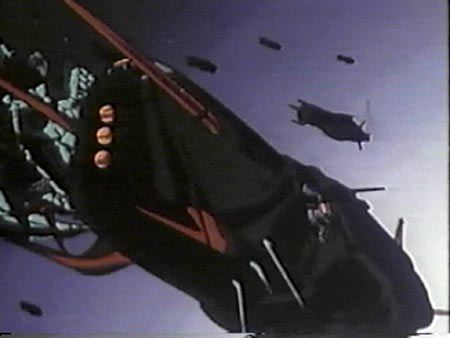
|
 |
 |  |  |  |  |  |
Names and disposition:
These ships were built at the Tirolian Orbital Shipyards and the Civralidor Fleet Yards from 1786 through 2003. All units of this class received regular updates as they came in for their regular refits and thus can all be considered to have belonged to one version at the end of their lives. The total number of Taul Detrel class destroyers constructed is 12,848.
Of this number, 937 were destroyed prior to 2010. As units of the Tirolian Home Fleet, these vessels were better supplied with the diminishing supplies of protoculture than many other ships. However, in 2013 only 594 remained in service, the others being drained of protoculture supplies and stored in deep space supply depots. To date these have not yet been discovered with the exception of one depot, which had been destroyed by the invading Invid forces. All of the operational vessels set out with the Robotech Masters for Earth. However, only 94 units of this class arrived with the fleet in the Sol system, the remainder having been drained and stored in a new deep space depot between 3 and 4 lightyears out from Sol as well. After the heavy fighting of the Second Robotech War, only 5 Taul Detrel destroyers survived, all damaged and in Terran hands. All others were destroyed. The captured vessels were stored at Moon Base Luna for examination and possible refit, but are not believed to be worth the effort of repair. However, research on these vessels has recommenced after the Invid departure.
Ship's Complement:
- Ships' crew (90),
- Air Group (102),
- Troops (30),
- Life support limits are for a full combat complement and about 1200 supernumeraries (1600 personnel total). For limited periods only an evacuation contingent of 10,000 souls could be embarked.
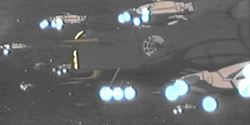
Dimensions:
- Length: 348 meters (main hull), 386 meters (over all).
- Width : 56 meters (main hull), 101 meters (over all).
- Height: 103 meters (main hull), 148 meters (over all).
- Mass : 240,000 metric tons (operational).
- Fuel Mass: 65,000 metric tons (typical).
Propulsion Systems:
- Main power system: Zorrelev-Qualdir-98 protoculture-fueled Reflex furnace cluster. The powerplant of a Taul Detrel class vessel can nominally deliver up to 432 Terawatts of power, and can operate for ninety minutes at maximum power before overheat initiates auto-shutdown.
- Maneuvering thrusters (44) : Fusion-plasma reaction thruster clusters with steerable nozzles. These engines in 8 groups of 4 and 2 groups of 6 engines. The two larger groups are mounted in the bow and stern, facing forward and aft respectively, two of the smaller are mounted on each side and the dorsal and ventral hull surfaces.
- Reaction-mass thrusters (1) : One Varrelev Qualdrun-113 fusion-plasma reaction thruster with protoculture energizer mounted in the rear of the ship.
- Secondary thrusters (7) : Four Varrelev Patronar-87 fusion-plasma reaction thrusters with protoculture energizer mounted in the center part of the ventral hull. Three Varrelev Paziastz 22 thrusters are mounted in the bow, facing forward.
- Anti-gravity system (1) : 8 Tsuaedrailar anti-gravity pods.
- Space fold (1): Nolfantom-proldarc'lev F87 spacefold. This system generates a hull-conformal fold.
- Planetary capabilities: The Taul Detrel-class has atmospheric capabilities through its reaction thrusters and anti-gravity system. The hull has sufficient structural strength for the ship to make a cold landing on it. Note that the ground underneath should be as firm as possible.
Endurance and mobility limits:
- The dry stores endurance was limited to about 2 months with a full crew complement. After that, the destroyer needs to restock. Water stores are recycled almost totally.
- The Reflex furnace can function for about 35 years at normal usage levels before an energizer rebuild is necessary.
- At full power, the main propulsion systems can nominally produce up to 6.6 Giganewtons of thrust at a minimal reaction mass efficiency profile, or as little as 24 Meganewtons of thrust at a maximum efficiency setting. At lower power levels, these thrusts are commensurately smaller.
- At full power, the Taul Detrel can nominally achieve a maximum delta-v of 400 kps at the cruising acceleration of 0.1 gees, a maximum delta-v of 80 kps at the battle acceleration of 1.0 gees, and a delta-v of at most 24.8 kps at the flank acceleration of 2.8 gees. At lower power levels, these ranges are commensurately smaller.
- The fold systems were not navigationally guaranteed for any single jump beyond 10 kiloparsecs. If longer voyages were required, the ship had to conduct multiple fold jumps.
- The maximum sustained atmospheric speed was limited to Mach 3. A higher speed could be attained while accelerating to orbit, or in emergencies, but this stressed the engines to above their sustainable heat tolerances. The maximum hover time on the anti-gravity systems was limited only by the protoculture supplies and maintenance requirements.
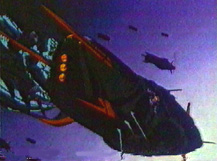
Weapon Systems:
- Makral Ditrosil 32 particle cannon (4) : The main armament of the ship has four mountings around the bow. These weapons share their mount with the Gluph Lihinal cannons, which actually fire through the Ditrosil 32 barrel. Unlike the most common Zentraedi weapons, the Ditrosil series was not a combined laser/particle cannon design. While the mount does include a laser, this is a relative low powered installation intended as a pre-fire 'tunneling' device for use in an atmosphere. The beam can be deflected by the magnetic coils at the end of the barrel by 45 degrees in each axis.
The Ditrosil 32 has an effective range of 300,000 km, an effective rate of fire of 15 full-power salvos per minute, and a maximum output of 2500 MJ. This gives the Taul Detrel more effective forward firepower than a far larger Tou Redir forward battery.
- Makral Ditrosil 34 particle cannon (4) : These weapons form the aft battery, arranged in a cruciform dispersion around the aft hull. In design, they are scaled down versions of the Ditrosil 32 forward cannons. Like those cannons, the -34 system incorporates a 'tunneling' laser. The beam can be deflected by the magnetic coils at the end of the barrel by 45 degrees in each axis.
The Ditrosil 32 has an effective range of 300,000 km, an effective rate of fire of 15 full-power salvos per minute, and a maximum output of 1200 MJ.
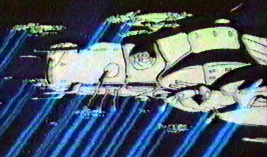
- Makral Ditrosil 36 particle system (2) : The -36 series of Ditrosil cannons is not a single-barrel system, but a triple-barrel system. The systems are located on the ventral edge of the forward hull, behind the main armament. Unlike other weapon systems on the Taul Detrel, this system is retractable, since it would be crushed by the hull of the Taul Detrel whenever it touched down. For reasons of improved protection, the barrels are generally retracted and only deploy seconds prior to discharging. The beam can be deflected by realigning the emission coils within the end of the barrel, and this can be done by 45 degrees in each direction.
The Ditrosil 36 has an effective range of 175,000 km, an effective rate of fire of 15 full-power salvos per minute, and a maximum output of 750 MJ per barrel.
- Makral Ditrosil 38 particle cannon (2) : The Ditrosil 38 series is the smallest particle gun mount on the Taul Detrel. The two barrels are grouped onto one mount, behind the cockpit facing upwards and aft, covering the dorsal fire sector. The mount can rotate through 360 and elevate through 90 degrees.
The Ditrosil 38 has an effective range of 100,000 km, an effective rate of fire of 15 full-power salvos per minute, and a maximum output of 500 MJ per barrel.
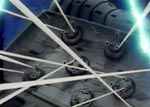
- Makral Taranoul 103 particle cannon (30) : This cannon formed the standard close-in weapon system of the Tirolian fleets. The cannons are mounted on an elevated structure in batteries of three cannons each. The triple batteries are distributed around the ship, with each aspect having at least two unmasked at all times. The Taranoul system has an effective range of 45 km against small targets, a practically continuous rate of fire and a power output of near 3 MJ/s at full power.
- Gluph Lihinal 24 anti-matter pellet rail cannon (4) : This bombardment weapon was developed by the Tirolians as an alternative to the Reflex cannon. The basic cannon is a railgun, mounted in a slender barrel beginning, oddly enough, at the end of a pylon. The cannon launches a pellet of anti-matter enclosed in a soliton wave field at a speed of 18.4 kps. When it strikes a target, the protective field dissipates and the anti-matter reacts with the surrounding matter. Four of these cannons were mounted on the edges of the forward hull. These were commonly fired in one salvo. The maximum mass of one pellet was about 40 milligrams, which gave a total salvo weight of 160 milligrams, sufficient to cause a reaction with a yield of 5.8 kT. However, the relative low speed of the projectiles made the weapon not very effective against enemy starships. The cannons were suited however for aerial bombardment, and were used for such.
Air Group and Mecha Complement:
Design Notes:
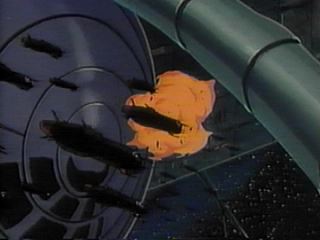
Though not through deliberate intent, the Taul Detrel is a ship that seems to radiate toughness and strength. Ton for ton, this impression is correct, for the Taul Detrel is among the most heavily armed small combatants yet designed.
The Taul Detrel hull has three distinct sections: the narrow forward section with the four antenna-like bombardment cannons, the main section which thickens out the center of the ship, and the aft section contains the main propulsion systems, including the fold drive.
The forward hull is narrow compared with the main section of the ship. It sprouts the command cupola, three forward thrusters, and the four antenna-like barrels for the two main weapon systems forward, and the two main docking ports more to the rear. The central hull is a flattened cylinder, with the curved section in the horizontal plane. The four ventral engines are housed in the lower part of this section. The tapering aft section houses the main engines.
The hull itself is a still classified honeycomb of alloys, plastics and ceramics, which out-performs every armour developed by Invid or Allied technicians at the time of this writing. It is remarkably robust in the face of incoming energy weapon fire or missile impacts.
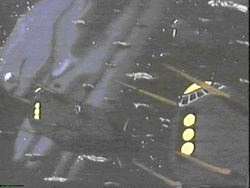
Internally, there are ten deck levels running throughout the bow and central sections. The aft section is mostly filled with the engines and several fuel tanks, and does not have a deck structure as such; rather, it has several access tunnels for engine maintenance and repair. The forward upper decks house the command facilities; below this, behind the forward sensor array, are the storage chambers for the bombardment gun ammunition supply. The lower part of the forward hull houses several major stores holds. The central section has three of its upper deck levels combined into one large mecha deck. This deck is partitioned into four sections, each section of course three deck levels high. Below and above the hangar deck are the crew quarters; below the lower crew quarters are the dorsal engines and their fuel tanks. A small shuttle hangar is located behind these engines, forward of the rear engine.
History:
The Taul Detrel class of destroyers is a direct descendent of the frigate classes built in the first days of the Robotech Empire as merchant escorts and general duty protection vessels. Those craft were designed to be maneuverable and small, yet to pack a respectable punch as their main task was the protection of Tirol's merchant fleets.
When in the late 18th century the outside threats against the Empire reached their apparent zenith and the Masters and Elders had taken up residence in the orbiting Motherships, the need for a powerful defense vessel capable of limited offensive action was keenly felt. The Taul Detrel was then designed from the Dendrasz Torkal type frigate. Compared with the older vessel (of which no examples remain), the Taul Detrel was larger and packed nearly twice the armament. In fact, for a given unit of mass, the Taul Detrel boasts one of the highest cannon output ratios ever achieved in non-reflex cannon armed vessels.
In addition to the particle armament needed for their anti-shipping roles, the Taul Detrel class mounted four anti-matter bombardment cannons. It had been hoped that these weapons could serve as a light-weight, low priming power, yet hard hitting main weapon system; however, the system fired too slowly to be of much use in a space battle unless utilized against very large targets. As a consequence it was a given that targets of the 'correct' size would be capable of destroying the smaller Taul Detrel before it had had a chance to lock on and fire its main armament. However, as a bombardment weapon against stationary targets, the system had its uses. Unfortunately for the Tirolians, though, the fuel for the weapon could only be created through an energy-wasteful particle transmutation process, as well as requiring extremely strict storage conditions. Consequently, when needed most, over Earth, the anti-matter was hardly ever available in any quantity, rendering the main weapons powerless.
Through a production run that spanned 217 years, nearly 12,850 Taul class destroyers were commissioned into the Tirolian defense fleets. Their heavy firepower, hull armor and maneuverability, coupled with the Tirolian's extremely effective command and control, ECM and sensor systems, gave the Tirolians the destroyer whose performance has become a yardstick with which to measure other designs. Although so far the various navies have been unable to copy the Taul Detrel class, all major navies have research projects ongoing on captured examples or left over debris.
See additional design notes.
Return to Tirolian index.
Go to Robotech Reference Guide Home Page.
Robotech (R) is the property of Harmony Gold. This document is in no way intended to infringe upon their rights.
Content by Pieter Thomassen, with Peter Walker and Rob Morgenstern
HTML by Robert Morgenstern (rmorgens@ieee.org)
Copyright © 2001, 2000, 1999, 1997 Robert Morgenstern, Pieter Thomassen, Peter Walker









